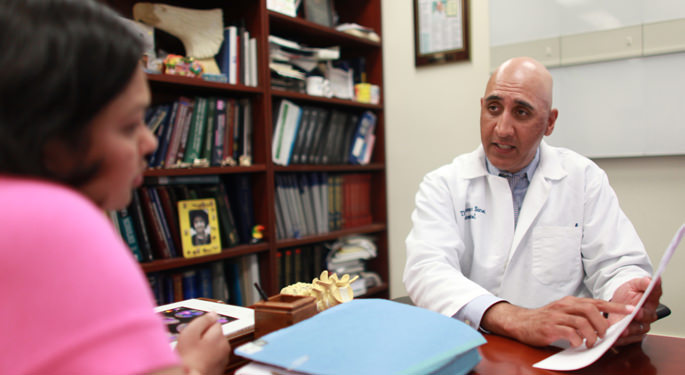Minimally Invasive Spine Surgery


Whenever possible, we at Mount Sinai prefer to perform minimally invasive spine surgery rather than “open” procedures. Minimally invasive surgery uses smaller incisions, which minimizes the disruption to the spine and surrounding soft tissue, decreases muscle tearing and blood loss, reduces pain and risk, and speeds up recuperation.
With minimally invasive spine surgery, we do not cut the muscles that overlay your spine but simply spread them out of the way and insert a small tube with endoscopes, intraoperative microscopes, and other specialized tools on the end. We use X-rays and computer navigation to help us see what is going on inside your body. When we finish the procedure, we remove the tube and your muscles return to their original position.
Conditions We Treat
We use minimally invasive spine surgery for a broad range of procedures and the number of conditions that we can treat in this way continues to grow. Conditions include the following:
- Compression fractures occur most often in the thoracic and lumbar spines of elderly patients with osteoporosis. Compression fractures can cause acute back pain that gets worse when you stand.
- Congenital spinal disorders usually occur because of a genetic or developmental abnormality. They can affect any region of the spine (cervical, thoracic, lumbar, or sacrum). We usually use surgery to stabilize the spine to allow for proper growth.
- Degenerative/arthritic disc disease and back pain, also known as "wear-and-tear" changes in the bones, ligaments, and discs of the spine, can lead to pain, weakness, or numbness.
- Herniated discs usually affect the cervical, thoracic, or lumbar spine. They stem from trauma or "wear-and-tear" changes. When you have a herniated disc, part of the disc bulges out of place and may put pressure on the spinal cord or nerve roots, producing back and leg pain, weakness, or numbness.
- Scoliosis is an abnormal curvature of the spine that can cause pain, decreased mobility, and heart and lung problems. Depending on the degree of curvature, we may need to perform surgery to realign your spine to improve your appearance and resolve pain, weakness, or shortness of breath.
- Spinal infections/osteomyelitis occur located in the vertebrae (bones), discs, or surrounding muscles of the spine. While we can often treat them with antibiotics, sometimes we need to do surgery to get rid of the infection.
- Spinal instability and spondylolisthesis happen when one vertebra “slips” in front of another, which can cause severe back and leg pain.
- Spinal trauma can cause damage to bone, ligaments, and muscles, and can destabilize your spine and spinal cord. We may need to do surgery to stabilize the spine and prevent further injury.
- Spinal tumors can be malignant (cancerous) or benign (non-cancerous). Even if they do not have cancer, we often remove tumors because they can cause structural instability in the spine, leading to fractures. Spinal tumors can also put direct pressure on the spinal cord and nerve roots, causing pain, weakness, or numbness.
- Spinal stenosis occurs when the spinal cord and roots in the neck and lower back become compressed.
Advances in Care
The Mount Sinai Health System is leading the way in using endoscopes (small cameras), tube-shaped retraction systems, and intraoperative computer-assisted navigation. Our neuroscientists and physician/researchers are advancing the limits of minimally invasive spine surgery. We offer a variety of minimally invasive spine surgeries including:
- Minimally invasive foraminotomy, laminectomy, and diskectomy enable us to treat nerve compression by making a small incision in your back and spreading the muscles away from the affected area. We can free the nerve from the compressing disc, bone, or ligaments. Patients often go home the day of surgery with significant symptom relief.
- Thoracoscopic thoracic surgery involvesplacing a miniature camera through a small tube in your body to view the spine and affected nerves. This helps us remove the herniated disc with minimal disruption to spinal stability and without having to perform spinal fusion, which means we will not need to create a long incision in your back for the placement of screws and rods.
- Laparoscopic and direct lateral (DLIF, XLIF) lumbar surgery is an innovative approach for patients who require a lumbar fusion. Our neurosurgeons access your spine through a small incision in your side, then spread the surrounding structures through a series of dilators. This approach allows access to the front of your spine (the anterior spine) with less risk than traditional open anterior surgery.
- Minimally invasive fusion and percutaneous pedicle screw fixation uses advanced imaging technology to guide the surgical instruments through a small, tube-shaped retractor.
- Vertebroplasty and kyphoplasty require only small incisions. We expand your compressed bone using a type of bone cement that corrects bone height and deformity.